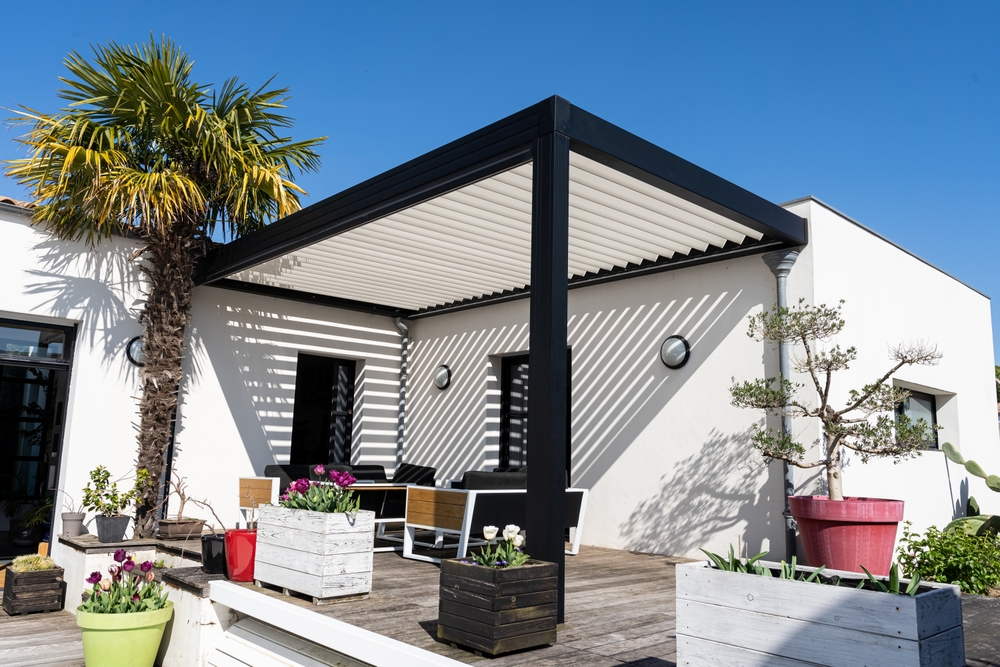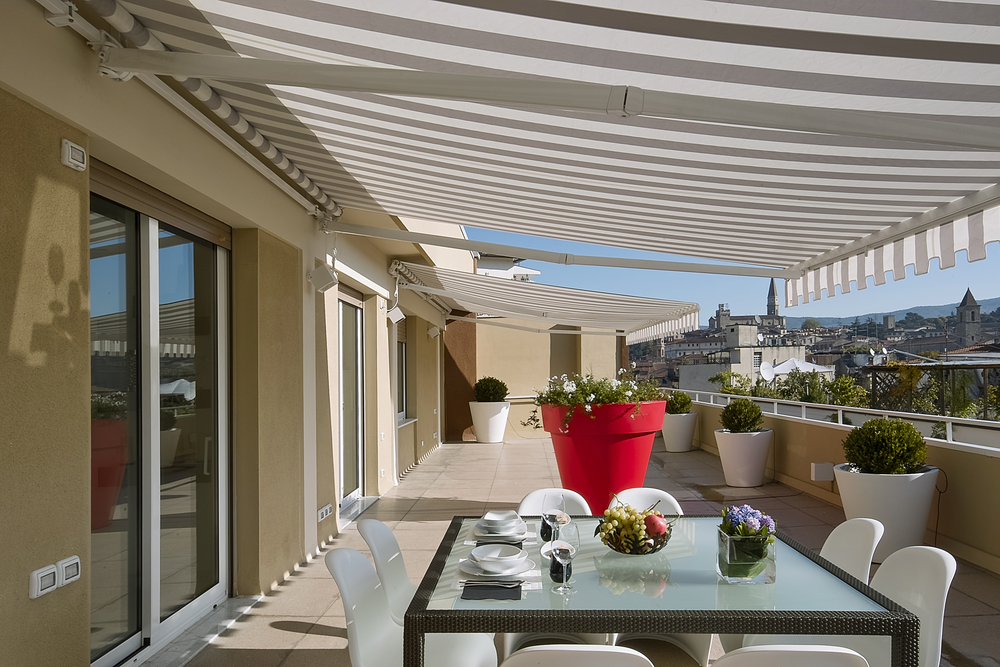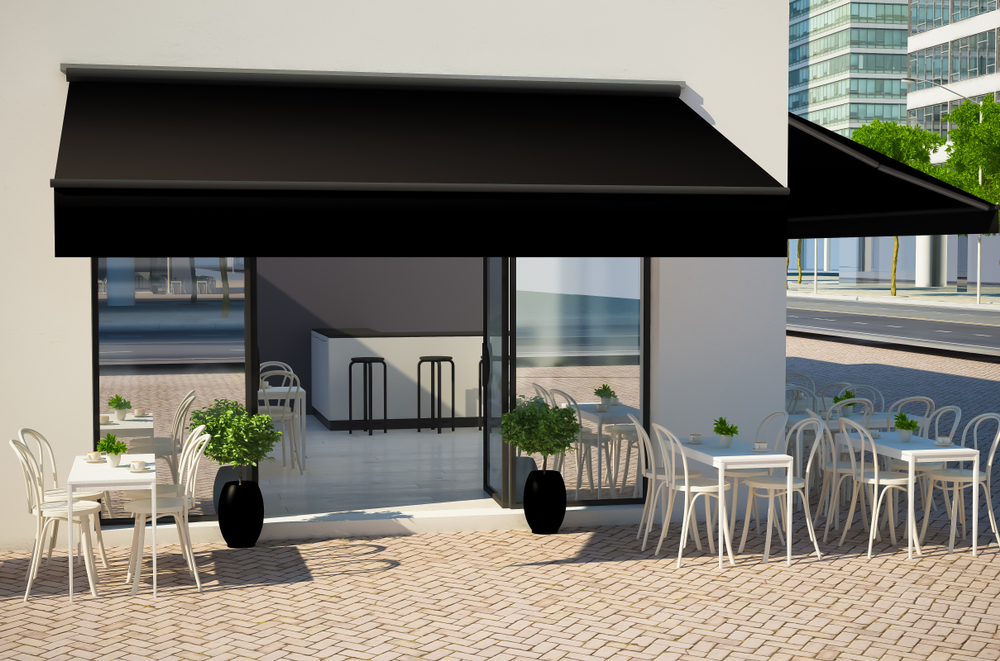Are you on the hunt to boost your home’s eco-friendly charm while also adding a touch of value and style? We understand, that juggling the task of incorporating green choices into our designs isn’t always a walk in the park.
Here’s a surprising nugget: savvy use of awnings can slash a home’s electricity bill by roughly 25%. This blog will dive headfirst into how weaving awnings into your home design plan can dramatically lift energy efficiency, making a solid impact towards sustainable living.
So strap yourself in for an exciting exploration into an innovative sphere where style warmly embraces sustainability!
Key Takeaways
- Awnings can reduce a home’s electricity bill by approximately 25%.
- They improve energy efficiency by providing shade and reducing the need for air conditioning.
- Awnings protect indoor furnishings from sun damage with their UV – UV-resistant materials.
- Professional installation ensures optimal functionality and longevity of awnings.
The Importance of Sustainable Home Design
Sustainable home design makes a significant impact, not just on our electricity bills but also on our environment. It incorporates eco-friendly construction methods and renewable energy integration to lessen our carbon footprint.
One way we can achieve this is through the use of awnings, which can be game-changers in creating energy-efficient homes.
A well-constructed folding arm awning alone can cut your home’s electricity costs by up to 25%. And it doesn’t end there – Awnings also improve air quality by maximising airflow, and reducing dependence on mechanical ventilation systems.
Think about how you could shield your house from harsh sunlight during summer while still allowing solar access in winter!
How Awnings Can Make Your Home More Sustainable
Awnings reduce energy consumption and costs, protect from harsh sunlight, and are made with UV-resistant materials.
Reduces energy consumption and costs
Awnings play a significant role in reducing both energy consumption and costs in your home. By providing shade and blocking the harsh sunlight, awnings can help keep your home cooler during the hot summer months.
This means you rely less on air conditioning, resulting in lower electricity bills. Well-designed awnings have been shown to reduce the cost of electricity bills by up to 25%.
So not only do awnings help create a more comfortable living environment, but they also save you money in the long run.

Protects from harsh sunlight
Awnings play a crucial role in protecting your home from harsh sunlight. They provide an effective barrier that shields your windows, doors, and outdoor spaces from the intense rays of the sun.
This not only helps to keep your indoor environment cool and comfortable, but it also prevents excessive heat gain, reducing the need for air conditioning and ultimately lowering energy costs.
Additionally, awnings are made with UV-resistant materials that protect against harmful UV radiation, safeguarding your furniture and flooring from sun damage. With awnings in place, you can enjoy the benefits of natural light without worrying about its negative effects on your home.
UV-resistant materials
When it comes to selecting the right awnings for your home, one important factor to consider is UV-resistant materials. These materials are designed to withstand the harsh effects of the sun’s ultraviolet (UV) rays and protect your home from sun damage.
By choosing awnings made from UV-resistant materials, you can ensure that they will last longer and maintain their appearance over time. Additionally, these materials provide an extra layer of protection against harmful UV radiation, keeping you and your family safe when spending time outdoors.
So when considering awnings for your sustainable home design, be sure to prioritise UV-resistant materials for long-lasting durability and reliable sun protection.
The Role of Awnings in Energy Efficiency
Awnings not only provide shade but also play a crucial role in improving energy efficiency, reducing heat gain, and protecting your indoor environment. Discover how awnings can transform your home into a sustainable oasis!
Reducing heat gain and cooling costs
Reducing heat gain and cooling costs is a significant benefit of installing awnings in your home. With the right shading design, awnings can block unwanted sun during the hot summer months, preventing excess heat from entering your home.
This means you won’t have to rely as much on air conditioning, leading to lower energy consumption and reduced cooling costs. Additionally, by reducing heat gain, awnings also help create a more comfortable indoor environment for you and your family.
So not only can you save money on your electricity bills, but you can also enjoy a cooler home without compromising on style or sustainability.
Improving overall comfort
Awnings play a significant role in improving overall comfort in your home. By providing shade and reducing heat gain, awnings help to create a more pleasant indoor environment, especially during the hot summer months.
Not only do they keep the sun’s rays from directly entering your home, but they also help to minimise glare and protect you from harmful UV radiation. With awnings, you can enjoy cooler temperatures and better airflow without relying heavily on air conditioning.
So, say goodbye to those uncomfortable sticky days and hello to a more comfortable living space with the help of awnings.
Protecting indoor furnishings from sunlight damage
Installing awnings in your home is not just about creating a shady spot to relax; it also plays an important role in protecting your indoor furnishings from sunlight damage. The sun’s rays can fade and discolour fabrics, carpets, and furniture over time, leading to costly replacements.
By blocking the direct sunlight that enters your home through windows and doors, awnings act as a shield against harmful UV rays. With their UV-resistant materials, awnings provide an effective barrier that helps preserve the beauty and longevity of your indoor furnishings. So you can say goodbye to sun-damaged furniture and hello to a protected and stylish home interior.

Selecting the Right Awnings for Your Home
When it comes to selecting the right awnings for your home, it’s important to consider factors such as the type, size, and material that will best suit your needs.
Choosing the right type, size, and material
When selecting awnings for your home, it’s important to consider the type, size, and material that will best meet your needs. Awnings come in various styles such as folding arm awnings or fixed structures.
Folding arm awnings are a popular choice because they offer flexibility and can be extended or retracted based on weather conditions.
Size also matters when choosing an awning. You’ll want to measure the area where you plan to install the awning to ensure a proper fit. A professional installer can help you determine the ideal size for your specific space.
In terms of materials, opt for UV-resistant fabrics that will provide long-lasting protection against sunlight exposure. This is especially important if you’re looking to shield indoor furnishings from sun damage.
Professional installation
To ensure that your awnings are installed correctly and function optimally, it is essential to rely on professional installation services. Expert installers have the knowledge and experience to securely attach awnings to your home’s exterior, ensuring they can withstand various weather conditions.
They will also ensure that the placement of the awnings maximises their sun-shading capabilities. By entrusting the installation process to professionals, you can have peace of mind knowing that your awnings will provide efficient energy savings and protect your home from harsh sunlight for years to come.
Awnings as a Sustainable Design Element
By incorporating awnings into your sustainable home design, you can not only contribute to reducing energy consumption but also enhance the overall aesthetic of your property.
Adding to your home’s green rating
Awnings are not only a practical addition to your home, but they can also contribute to your home’s green rating. By reducing energy consumption and costs, awnings help make your home more sustainable.
They provide shade and protect against harsh sunlight, minimising the need for air conditioning and reducing reliance on artificial lighting. With UV-resistant materials, awnings also offer protection for indoor furnishings from sun damage.
Investing in awnings is a smart choice that can enhance both the sustainability and value of your home.
Serving as a design feature
Awnings not only provide practical benefits but also serve as a stylish design feature for your home. With a wide range of colours, patterns, and materials available, you can choose awnings that complement the overall aesthetic of your property.
Whether you prefer a modern look or something more classic, there is an awning option to suit every style. By integrating awnings into your home’s design, you can enhance its visual appeal while still enjoying the energy-saving and sun-protective benefits they offer.
In addition to their functional advantages, awnings add character and charm to any outdoor space. They create a welcoming atmosphere and can even be used to define different areas within your backyard or patio.
Achieve a Sustainable Home
In conclusion, awnings play a vital role in sustainable home design by reducing energy consumption and costs, protecting against harsh sunlight, and improving overall comfort. They are an eco-friendly solution that not only adds to your home’s green rating but also serves as a stylish design feature.
Choosing the right type of awning and professional installation can further enhance their effectiveness in creating an energy-efficient and environmentally friendly home. So why not consider adding awnings to your sustainable home design plans?

